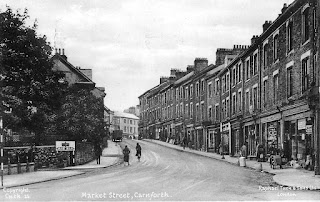We follow the Lancaster Canal into the small town of Carnforth. Here's the marina in 2010 (Creative Commons License).
Market Street, many years ago.
The fire station in 2021.
Nearby is the War Memorial.
Carnforth was - and still is - an important place on the railway. In the sidings in 1905, we see LNWR 2-4-2T no. 2149.
The interior of the railway station in pregrouping days. The film 'Brief Encounter' was made here, in the waiting/refreshment room.
LMS, ex LNWR 0-8-0 no. 9117 at Carnforth shed. (Photo in my collection, photographer unknown).
Now for a couple of pics around the shed in 1967 (Les Flint).
The last year of steam, 1968, and 44871 is seen by the coaing stages. (Les Flint)
After closure, Carnforth shed became a museum and various locos were to be found there.
There was even a lengthy miniature railway.
Some preserved buses were often to found in the shed yard, this one from Lancaster Corporation.
The loco shed is no longer a museum, but is used as the main depot of West Coast Railways. Meanwhile, back at the station, it's 1967 and the last of BR's steam locos are still in action. (Les Flint).
Northern is the main operator serving Carnforth today. 156444 is seen here in 2006.
First Trans Pennine 175088 passes through, again in 2006.
Northern's class 195 units are a common sight today.
The main line platforms at Carnforth have been removed and Pendolinos pass through non-stop.
One of the rooms in the former up side buildings has been put to good use as The Snug, a great little micropub.
Stagecoach run nearly all the buses serving Carnforth.This one is painted into the old Ribble colours.
One can even get an open-top ride! A bit chilly in January 2022.
Excellent beer, food and accomodation can be had at the Royal Station Hotel.
We conclude our look at Carnforth at another micropub, the Taps on the Green. Limited opening hours, but don't miss it.
The next post we see us entering what is now Cumbria.
























































